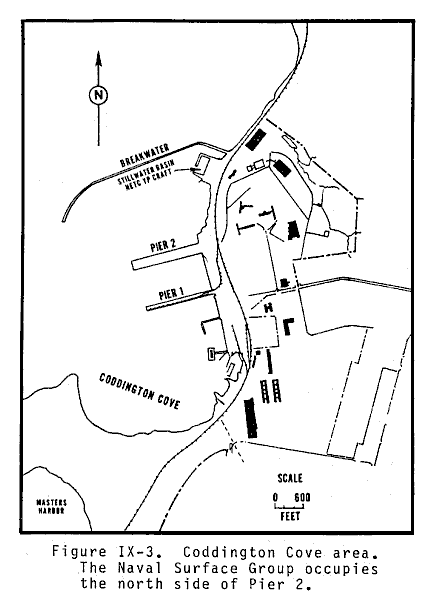




From its infancy during the Revolutionary War to its present day sophistication, the United States Navy has been a part of Narragansett Bay. The first Commander-in-Chief of the Continental Navy, Rhode Islander Esek Hopkins used the bay as a haven for his small fleet between combat engagements. During the Civil War, the government transferred the faculty and student body of the US Naval Academy from Annapolis to Newport.
In 1869 the Navy authorized the establishment of an experimental torpedo station at Goat Island. The torpedo station reached its peak of importance in World War II, when more than 13,000 persons were employed on three shifts in the manufacture of 80 percent of the torpedoes used by our country during the war. The station was the largest single industry ever operating in Rhode Island. In 1940 Congress appropriated money for construction of a Naval Air Station at Quonset Point on the West Side of the Bay which went into operation in 1941 In 1951 the Torpedo Station was permanently disestablished, and the manufacture of torpedoes was awarded to private industry. Goat Island was transferred to the City of Newport, and redevelopment of the island included a causeway, luxury hotel and restaurant, marina, shopping facilities, and apartments. In place of the Torpedo Station, a new research development facility, the Naval Underwater Ordnance Station, was established. A merger in 1970 with another naval activity in New London, Connecticut, created what is now the Naval Undersea Warfare Center (NUWC).Early in 1973, a Shore Establishment Realignment study directed the closing of the Quonset Point Naval Air Station, a drawdown of facilities at Davisville, the movement of the active fleet from Newport, and a cutback of personnel and activities. Five previously independent commands were disestablished and their personnel absorbed by a new activity - the Naval Education and Training Center (NETC). A series of Base Realignment and Closure (BRAC) commissions changed the Navy in Newport to the approximately 30 different naval and Department of Defense commands and activites resident today.
The Naval Education and Training Center is an amalgam of five former shore commands - the Naval Base Staff, Naval Station, Naval Officer Training Center, Public Works Center, and the Supply Center Annex. Newport is the home of the Navy's most prestigious educational institution, the Naval War College. The oldest such institution in continuous existence anywhere in the world, the college is organized to pursue and integrate both academic and research endeavors. The Naval Undersea Warfare Center Division Newport (NUWCDIVNPT) is the Navy's principal research development, test, and evaluation center for submarine weapons systems.
In 1974 the Rhode Island Port Authority and Economic Development Corporation was established to oversee the redevelopment of ex-Navy holdings, leaving the mainstay of the Navy presence centering on the Naval War College on Coasters Harbor Island and the Naval Education and Training Center at Coddington Point on the southern tip of Coddington Cove. The State Port Authority controls and Derektor Shipyard leases Pier 1. Shallow draft craft and the four Naval Education and Training Center yard patrol craft are berthed at the Stillwater Basin to the north of Pier 2. Visiting deep-draft vessels under Military Sealift Command occasionally may berth for short periods to discharge or load stores at Davisville (north of Quonset Point) by arrangement with the State Port Authority. Most of the traffic from these piers is now concerned with offshore oil and gas drilling operations. The large pier at Quonset Point, which formerly provided berthing for aircraft carriers, is a concrete-capped wood piling structure in a poor state of repair; it probably will not be used by visiting naval vessels in the foreseeable future. The Melville Fuel Depot is only rarely used by US Navy ships. Most ocean-going traffic into Narragansett Bay enters via the central East Passage channel. An additional dredged channel from East Passage running northwestward to Quonset Point provides access for naval vessels to anchorages in West Passage to the south of Quonset Point. West Passage is frequently utilized by lighter draft vessels and tows, especially those bound for the Graduate School of Oceanography Pier and piers at Quonset/Davisville. The project depth for the channel to Providence is 40 ft, and remaining channels have a project depth of 35 ft. Silting at the port of Providence and at other points along the channel, however, restricts the maximum draft of vessels handled at the port to 35 ft. This restriction on the depth of dredged channels stems from a total embargo on dredging in the Narragansett Bay area that has been in effect since 1971. The embargo was the result of a successful legal suit brought against the Army Corps of Engineers to prevent any further dumping of polluted dredging spoils at Brenton Reef, 5 n mi south of the East Passage entry to the Bay.
